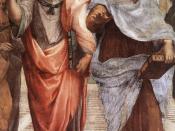Plato and Aristotle both believe in tripartite souls. These are souls, which have three parts. Plato believed the soul had a reasoning part, and emotive part and a desiring part. He also believed each of these parts had a virtue, or arête. The virtue for reason was knowledge, the virtue for emotion was courage, and the virtue for desire was self-control. With each of these virtues, we can overcome the wanting parts of the soul and become good, rational thinking people. Plato said once all three virtues had been acquired, we would have the perfect psyche, or soul. According to Plato, the soul is placed inside the body at birth, after it has travelled from the realm of the forms. This is called a transcendent soul. When it arrives in the body, it forgets the forms. However, it can remember, with the aid of a philosopher. This process is called anamnesis.
The forms are perfect beings- what all beings in the temporal special, or shadow world (the world we live in now), aim to be like. For example, in the realm of the forms, resides the perfect circle or square. The highest form is the form of the good. All forms are derived from this. We know the forms through experience prior to knowledge, a priori. Plato likens this remembering of the forms to his myth of the cave. This is a story that tells of several individuals bound in a cave. They are bound so they cannot see each other. All the can see is the wall of the cave. On this wall, shadows flick backwards and forwards. These are shadows of items and statues carried on people's heads in front of a fire. The people in this cave think that the shadows are all there are,


